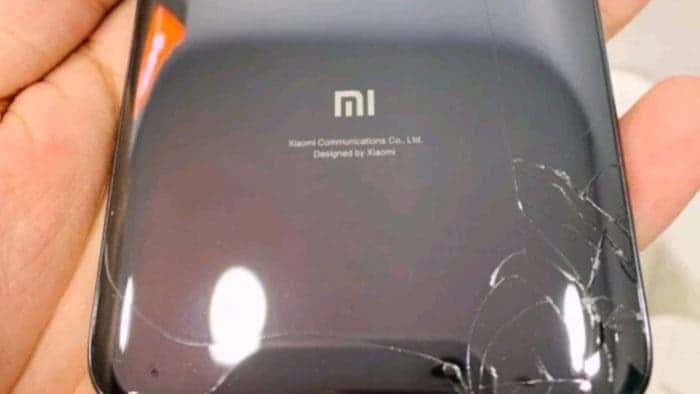A few days ago, Lei Jun’s speech in honor of Xiaomi’s 10th anniversary has aroused industry attention. Lei Jun will talk about where Xiaomi comes from and where it will go. This decade has been very windy and has many pitfalls.
In the past, Xiaomi has focused on model competition and low-end market shipment data packaging for a long time. Xiaomi lacks the underlying technology and its shortcomings are hard to fix.
Xiaomi used to continue to package new stories to cater to the capital market. But as domestic and foreign sales continue to decline, there is still no turning point. So the hidden worries of Xiaomi in the 5G era have emerged.
According to a Counterpoint report, in the second quarter of 2020, smartphone sales in China fell by 17% year-on-year, but increased by 9% month-on-year. At the same time, Huawei’s smartphone sales in China increased by 17% year-on-year, with a market share of 47%. Xiaomi’s sales in China and India are on a downward trend. Xiaomi’s smartphones fell by 35%, the largest decline, with a domestic market share of 8.4%.
IDC data also shows that the total shipments of Xiaomi smartphones in the second quarter were 10.5 million units, a decrease of 6.6 million units from 17.1 million units in the same period last year, a year-on-year decline of 38.4%, and the largest decline among major manufacturers.
The story of product benchmarking channels (Or the root cause of the decline of Xiaomi smartphones)
Let’s look back on the history of Xiaomi. Xiaomi, which was established in 2010, achieved miraculous effects during the smartphone dividend period with its ‘price-performance ratio’ strategy. In the third quarter of 2014, it became the third-largest smartphone manufacturer in the world and the number one domestically produced smartphone manufacturer.
Later, from 2015 to 2016, as the low-end market gradually became saturated, Xiaomi’s growth weakened. According to IDC’s report, in 2016, Xiaomi’s smartphone shipments were 41.5 million units, and the overall shipment of Xiaomi’s smartphones fell 36%. And its market share dropped from 15.9% in 2015 to 8.9%. Xiaomi was the fifth in the ranking of domestic shipments.
In this year, the Xiaomi model has actually buried a hidden worry. Because by 2016, Xiaomi has been trapped by the price-performance ratio for 5 years. In the past five years, Xiaomi has been in the lowest price range. It has never solved the problem of its smartphone brand image and industry brand power. So it has not been able to drive the high-end brand upward.
At that time, there were two ways:
- to learn from Samsung in terms of the control of technology and supply chain and other links to establish a technology-based corporate image;
- to learn from Apple’s integration of software and hardware.
In fact, Huawei’s route at the time was to learn from Samsung and establish a technological brand image.
Xiaomi has tried to benchmark Apple. But due to the lack of control of the underlying system, it is difficult to understand the integration of software and hardware with the MIUI customized system as the core. In addition, there have always been shortcomings in the supply chain.
Xiaomi Is Like Amazon
Lei Jun said in 2014 that Xiaomi is like Amazon. Xiaomi sells smartphones just like Amazon sells Kindle. Xiaomi was the third largest e-commerce company in China at the time. Both of them have deployed hardware based on cost-effective strategies.
Later, at the 2015 ‘Wuzhen On Dao·Digital China’ forum, Lei Jun did not shy away from the idea of becoming a ‘Sony of China’. It allowed ‘high-quality products with low prices and high reputation’ to be recognized by larger masses. Later, Xiaomi proposed to learn from Costco’s model and MUJI, focusing on design, quality, and comprehensive retail stores. Low SKU brings low inventory cycles, improved capital efficiency, and reduced operating costs.
Xiaomi has no problem with Apple and Sony. But later with Amazon, Costco, and MUJI, the essence is that the company as the product gene is benchmarking the retail channel.
This kind of channelized ecological chain strategy actually ignores a key issue: as a technological product, smartphones are difficult to avoid through technological improvements to polish products and enhance brand power. If smartphones become one of the channel strategies ring, this has deviated from the normal upgrade path and logic of technology products. This may be the root cause of the domestic decline of Xiaomi smartphones.
Heavy bet on shipments to the Indian market lost: Xiaomi missed the key opportunity for technology and brand improvement
Under the retail store channel strategy system, Xiaomi has always focused on rapid channel shipments, sales volume, and inventory turnover efficiency in the past. When domestic worries emerged, it continued to expand hardware products, and then copied the domestic game to India. This was especially seen on the Redmi phones. But this kind of gameplay delayed the resolution of brand problems and technical shortcomings.
In 2017, Xiaomi stopped falling and rebounded. Lei Jun said at the time that Xiaomi was the first smartphone manufacturer that could rebound after sales decline. However, the engine of Xiaomi’s growth against the trend at the time came from the Indian market. In the list of ‘Top Ten Best-selling Smartphones in 2017 in China’ compiled by Counterpoint that year, it was basically contracted by manufacturers such as OV, iPhone, and Honor. Xiaomi only had one Redmi phone that took the ninth place.

In the Chinese market, smartphone manufacturers ushered in a window of opportunity for brand upgrades from 2017 to 2018, because the demographic dividend of the low-end smartphone market has disappeared. To maintain domestic growth, it is necessary to drive the brand upward.
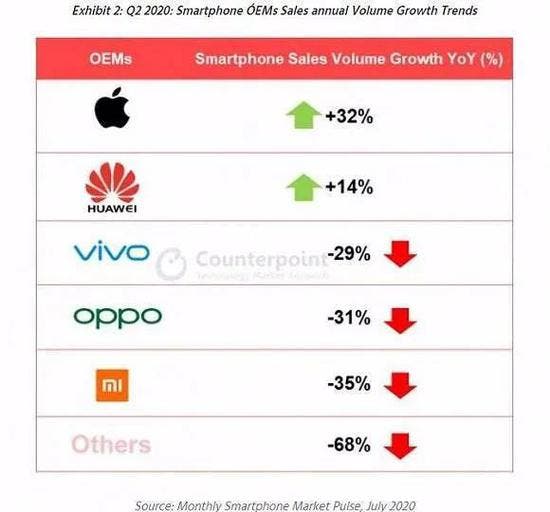
In 2018, products from manufacturers such as Huawei began to enter the niche of 5,000 yuan ($717) models. Those smartphone makers were spending too much on R&D. At that time, Huawei’s HiSilicon chip was upgraded with great momentum. And breakthroughs in the system level such as GPU Turbo technology, super file system, and Ark compiler brought its brand power to improvement.
Xiaomi lays behind its competitors
In addition to the fast charging technology, OPPO and VIVO have introduced innovative technologies for lifting cameras. OPPO has the Find X, VIVO has the NEX and other high-end flagships that have attracted attention. They also promoted the improvement of brand power. But Xiaomi still uses Redmi to fight the world.
The advantage of brand upward is that it can raise the average price and also have brand advantages in the low-end market. Look at the average prices of major smartphone brands in 2018: Apple – 5701 yuan ($818), Samsung – 3853 yuan ($553), Huawei – 2463 yuan ($353), OPPO – 1990 yuan ($285), VIVO – 1907 yuan ($274), Honor – 1443 yuan ($207), Xiaomi – 1374 yuan ($197), Gionee – 1307 yuan ($187), and Meizu – 1170 yuan ($168). In 2018, IDC data showed that the Xiaomi market’s annual shipments dropped by 34.9% year-on-year.
In 2019, Xiaomi, which focuses on reaping the dividends in the Indian market, is in a continuous decline in the domestic market. This year, apart from the Xiaomi Mi 9, there is no flagship product that has sparked hot discussions in the industry. In 2019, smartphone shipments throughout the year compared with 2018, was down by 21%. Its market share decreased from 12.4% in 2018 to 10.5%.
By this year, Xiaomi’s market share has fallen to single digits.
The current problem for Xiaomi is that both domestic and foreign markets are facing a stall crisis. First, due to geopolitics, epidemics and other factors, the current Indian market is facing uncertainty. A recent data report from Canalys shows that Xiaomi’s 2020
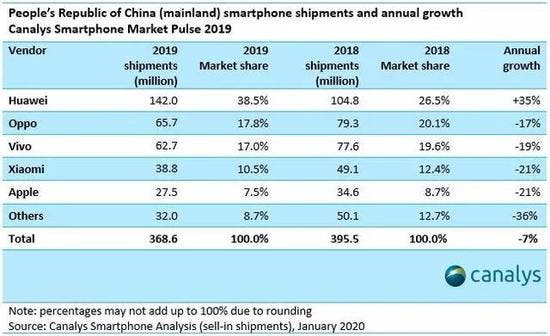
Q2 shipments in the Indian smartphone market are 5.3 million units, a decrease of 5 million units from 10.3 million units last year, and Xiaomi’s sales plummeted 48%.
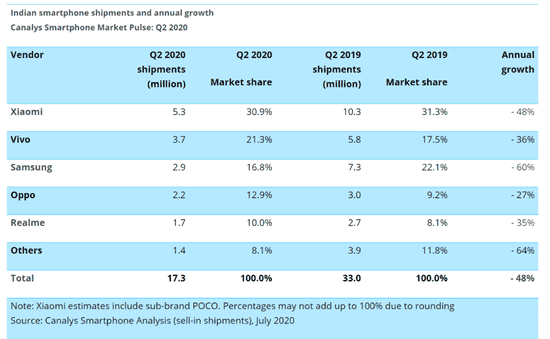
Xiaomi’s cost-effective gameplay in the Indian market has been copied by OV, especially by VIVO. The latter rose rapidly from 13.1% in 2019Q1 to 21% in 2020Q1 within one year.
Moreover, the Indian market is stalling. The importance of the domestic market to Xiaomi has become more and more prominent. This year, Xiaomi has reverted its strategic focus to the country. At the beginning of this year, it released the Xiaomi Mi 10 in an attempt to hit the high-end niche and create a single product explosion. But things went contrary to expectations.
In terms of single product models, among the top ten sales of 5G smartphones in the Chinese market in June this year, Huawei (including Honor) accounted for eight seats, OPPO accounted for two, and there was no Xiaomi smartphone in the top ten.
The essence behind this is that in the 5G era, it is becoming more and more difficult for Xiaomi to go the premium market. This is related to the fact that 5G places special emphasis on hard-core patents and technologies, especially in the current sensitive and complex international trade situation.
5G has more requirements
On the one hand, 5G terminals have new requirements in terms of network architecture, multi-mode, frequency band and bandwidth, OFDM parameters, frame structure, modulation mode, MIMO, power, etc. It is necessary to optimize the experience through patent layout, reduce costs, and be able to perform at critical moments in order to gain more technological autonomy.
On the other hand, in the smartphone manufacturing process, the chip is a key link. It determines the smartphone’s performance compatibility, modulation adaptation, processing operation and many other aspects. Xiaomi is missing in this link. Judging from the history of the smartphone industry, if there is no mature self-developed chip and system design capabilities or no control over the supply chain and core technology, it is basically impossible to achieve high-end brands.
5G+AIoT
5G+AIOT is another big story Lei Jun told the capital market. The Xiaomi smartphone is the leading product of AIoT.
The Xiaomi IoT front is very broad. There are more than 2,000 Xiaomi and ecological chain products. The number of connected devices reaches 252 million, covering most of the smart hardware fields. The current performance of Xiaomi IoT is still good. The proportion of IoT and consumer revenue rose from 25.1% in 2018 to 30.2% in 2019. IoT revenue reached 62.1 billion yuan ($8.91 billion) in the same period.
However, other companies are focusing on this field as well. For example, Huawei has formulated a 1+8+N strategy on IoT and launched its own HiLink standard. Huawei also set a three-year goal in its IoT strategy: 1/3 of China’s IoT devices support the HiLink standard. In 2019, the cumulative shipment volume of Huawei IoT connected devices has exceeded 220 million. Not only Huawei, other manufacturers such as OPPO, VIVO, and Realme are also accelerating their deployment in IoT business.
Can IoT save Xiaomi?
The efforts of these manufacturers, especially Huawei, which has the advantages of 5G, pose a certain threat to Xiaomi. Because of the IoT era, 5G is the underlying infrastructure. The layout of IoT requires continuous investment of resources to ensure efficient operation. The realization of IoT requires smartphones, a popular and powerful portal to integrate various devices and scenarios. The user stickiness and competitiveness of smartphones is quite critical. If the smartphone terminal weakens, it may affect the competitiveness and user stability of ecosystem chain manufacturers and camps.
The story of 5G + AIoT is in line with the general trend of the entire era, because after a large number of hardware products are connected to the Internet, the information interaction of hundreds of millions of people requires the platform to provide the underlying soil for a series of applications to connect everything through 5G transmission and capacity. But if the layout of 5G core technology is hollowed out, this story is not convincing.
Huawei ranks first in the world with 3147 5G standard essential patents
In China, VIVO has also applied for more than 2,000 5G invention patents. In addition, the intellectual property data released by the State Intellectual Property Office earlier shows that in the first half of 2020, the number of OPPO invention patents granted ranks the first echelon. But in the 5G patent, there is no shadow of Xiaomi on the list.
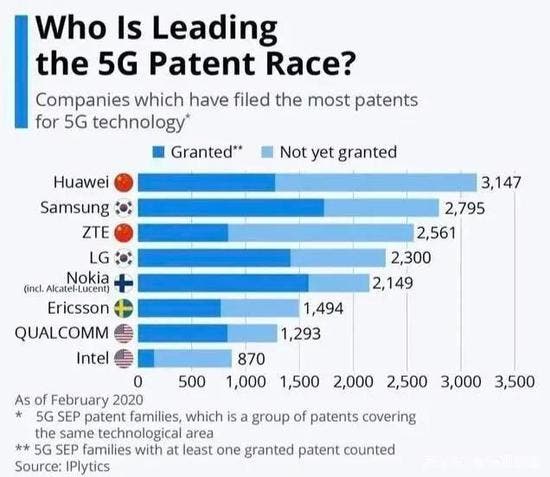
Xiaomi wants to tell a story about the Internet, smart hardware, and IoT platforms. But the weakening of smartphone competitiveness and the lack of 5G technology means that the locomotive, the central control core of IoT, is slowing down. Whether the IoT ecological chain can maintain growth is still a question.
Also Read: Huawei’s 5G Patents Surpass That Of All Us Companies Put Together
This is why the capital market did not buy it when Xiaomi talked about the continued acceleration of AIoT business. And Xiaomi’s stock price was still hovering at the issue price for two years after its listing.
Which markets should Xiaomi focus on?
At present, the importance of the domestic market is self-evident for Xiaomi. However, behind the decline of Xiaomi’s domestic market is that the retail model of Xiaomi’s products in the benchmarking channel in the past made it obsessed with the layout of hardware department stores, harvesting the dividends of the Indian low-end market, and missed the pass. The best time window to invest in technology research and development to drive brand premiums.
Xiaomi has always focused on telling stories about retail shipments and low-end sales. After eating up the domestic market dividends, they switched to India. This is the result of Xiaomi’s model – the product benchmarking retail channels, because the essence of retail is how to be more effective. Selling goods is a business model rather than a product development model.
As a technology product, the barriers to competition stem from long-term investment in research and development, control of the upstream and downstream industrial chain and core technologies to establish product and brand barriers. But Xiaomi’s retail-driven approach and this model of heavy investment in research and development are contradictory. This is also an important reason why Xiaomi’s surging chip project was finally abandoned. This heavy investment approach does not meet the strategic positioning of Xiaomi’s retail model.
But this is precisely the reason why Xiaomi’s brand premium cannot rise and the competitiveness of the domestic market has declined. The gap between its technology and product innovation capabilities and Huawei and other manufacturers has been further widened.
Secondly, Xiaomi’s hardware industry chain involves too much energy. Xiaomi’s main smartphone business is products and technology investment is insufficient. So the product level is at a disadvantage.
Xiaomi spends too little on R&D
As mentioned earlier, as a technology product, the smartphone’s innovation is mostly driven by technology. And technology requires a large amount of long-term investment to ensure stable innovation and iteration of the product.
According to the data, Xiaomi’s research and development expenses from 2015 to 2018 were 1.512 billion yuan ($0.22 billion), 2.104 billion yuan ($0.032 billion), 3.151 billion yuan ($0.45 billion), and 1.104 billion yuan ($0.16 billion). According to Xiaomi’s 2019 financial report, Xiaomi’s research and development expenses have increased to 7 billion yuan ($1 billion), while the research and development expenses of VIVO and OPPO in the same period are close to 10 billion ($1.43). Huawei’s research and development investment in 2019 is as high as 131.7 billion yuan ($18.89 billion). Judging from the current market share and brand power, the investment in technology research and development has a positive correlation with the product brand.
Lack of innovations
Xiaomi’s lack of investment in research and development, to some extent, stems from the continuous expansion of the hardware ecological chain. But it has dispersed the company’s capital and technical investment in the main business of smartphones. When Xiaomi’s competitiveness in the smartphone field is declining, the funds that can be invested in research and development are limited. How can a hardware department store that is not profitable and faces a wide range of investment pressures in the hardware industry chain focus on resources and technology in the high-end smartphone market? Also, how it can compete among the leading smartphone manufacturers?
Lastly, Xiaomi’s 5G basic communication technology and the lack of chips determine that it will be used for a long time through the supply chain doctrine + stacking model. However, with the industry’s doubts about the lack of core technology of its products, Xiaomi’s future high-end positioning will always have a lack of confidence. The marketing-driven model may no longer adapt to this era, and it is hard to say that it drives brand value. Judging from user feedback on social media such as Weibo, provocative marketing to peers can easily lead to consumers’ boredom and disgust. Xiaomi needs to change its style of play.
The bottom line
In 10 years, Xiaomi is no longer the original Xiaomi. But the times have changed, and it is difficult for Xiaomi’s model and marketing methods to adapt to this era. Especially in the vent of the trade war, consumers have placed more expectations on technology-based manufacturers.
Looking back on the past 10 years, Lei Jun will show people the brilliance and feelings of Xiaomi. But at this juncture, Xiaomi should actually reflect on Xiaomi’s shortcomings and crisis.

